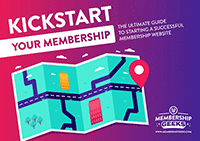Setting goals for your membership is an essential part of fuelling continuous growth.
But simply setting them isn't enough…
Actually following them through and achieving your goals is a whole other challenge.
And often that's where people fall short.
To make sure you get where you want to go, you need to have a solid process; one that not only ensures that the goals you're setting are realistic, but also achievable.
Setting unrealistic goals without a clear plan of action pretty much guarantees failure.
If this sounds familiar, don't worry, we've got your back!
In this article, we'll be sharing with you a practical goal-setting method that we've used to grow the Membership Academy.
Following this process will to help you determine both the future of your membership and map out how to get there.
So let's dive in…
6 practical steps to setting (and achieving) better goals
The process we use consists of 6 steps that form the acronym CO-STAR.
- Current situation analysis
- Objective/Goals
- Strategy
- Tactics
- Action Steps
- Review
This simple process can help you to develop a practical plan for achieving your goals.
Let's break CO-STAR down into a digestible goal-setting method for your membership:
1. Current situation analysis
Before you can set any achievable goals, the first step is to take stock of where your membership is currently.
A comprehensive audit can reveal any problems or issues that you'd like to address with your goal setting…
So it's vital that you take a long, hard, honest look at your membership.
Think about any challenges you're facing, what your membership's strengths are, and where there are any potential threats, weaknesses, or opportunities.
Perform a thorough analysis of all aspects of your membership business.
Consider things like:
- Key Performance Indicators (KPIs), including churn rates etc
- Engagement
- Revenue
- Sales
- Year on year growth
Taking everything into account;
- How do you feel about your membership's performance over the past 12 months?
- Has it met your expectations?
- Are you happy with it?
- Are there any obvious areas where things can improve?
The process of achieving your goals is a journey, so before you start plotting your stops along the way, you should know where your starting point is.
2. Objectives and goals
Your analysis should reveal aspects of your membership that you want to improve or challenges that need overcoming.
These will form the basis for the goals and objectives you aim to achieve over the next year.
Decide where you want your membership to go and what you want it to accomplish.
What are your short-term, mid-term, and long-term membership goals?
A common target for membership site owners is to increase sign ups.
But writing down the words “I want to increase the number of members in my site” isn't enough…
You need to have an understanding of how many new sign ups you want for your membership, how you're going to achieve this and the timeframe in which you want to complete it.
In other words, your goal needs to be SMART.
What are SMART goals?
This is a popular way to approach goal setting.
Ensuring your goals are ‘SMART' makes it easier for you to determine how close or far away you are from achieving them.
SMART stands for Specific, Measurable, Achievable, Relevant, and Time-bound.
Each goal or objective should meet all five of these categories to make them successful.

Your goals should be as smart as this cat…
Instead of “increase the number of members”, you can use the SMART goal method to refine your goal to “increase new membership sign-ups by 10% in 3 months“.
This is specific as you know you're aiming to increase membership sign-ups only by 10% of your current rate or more.
This also makes it measurable.
If you notice an increase of 6%, then it's clear that you haven't hit your goal yet.
Is it achievable?
That's really up to your membership, but by selecting a more realistic figure (like 10% instead of 90%), you won't feel demotivated if it takes longer to reach your target.
It's also up to you to decide if this goal is relevant to your long-term membership plans.
There's no point in setting goals that aren't going to take you to where you want to be, so make sure that they'll keep you on track to achieving your overall vision.
By setting a time limit, you give the goal a realistic endpoint.
This helps keep you motivated and lets you know when you should measure its progress.
But the goal-setting process doesn't stop once you've written your SMART goals.
These lead to each choice and decision you'll make to achieve them.
3. Strategy
After you've decided on your goals, you'll need to think about how to reach them.
This is the ‘how' part of the process.
- How are you going to achieve your goals?
- What overarching strategy do you need to get you from where you are now to where you want to be?
Each goal should have at least one key strategy that can help you work towards achieving it.
It's fine to have more than one.
Just make sure that you know your plan of action for each.
4. Tactics
Tactics are the specific processes you'll implement so your strategy succeeds.
But it's easy to get confused when it comes to tactics and strategy.
Here's a quick example to highlight the difference between the two:
Your assessment reveals that your year-on-year growth has reduced, and your member revenue is stagnating.
So, you set a SMART goal: to reduce member cancellations by 25% over the next 12 months, in order to boost recurring revenue.
Your strategy is to improve your members' experience by encouraging higher community engagement and content consumption.
You hope that this will reduce cancellations so that you can reach your goal.
Your strategy is your high-level plan, but simply saying “improve members' experience” is too broad to follow successfully.
Just like with SMART goals, specificity is key to knowing your next steps.
Breaking down your strategy into smaller tasks will make it more manageable to work towards.
These focused tasks are your tactics.
For this example, your tactics might be to improve member onboarding, introduce gamification, or survey your members to get a better picture of why they joined and how happy they are.
As you work through each tactic, you should keep your strategy in mind.
This way, your objectives lead each step of the process.
While you might have more than one strategy for each objective, each strategy can have many tactics supporting it.
5. Action
These are the practical steps that you need to take.
Think of it as your ‘To-do' list.
But it's also the simplest part of the process to complete, as each step should be one actionable item.
Going back to our example, we could take the tactic “improve member onboarding” and make a list of actions to complete this.
This might look like:
- Analyze open rates of your email onboarding sequence
- Rewrite subject lines for emails that have less than a 25% open rate
- Add a new email to your onboarding sequence
- Record a new welcome video
As each of these actions gets ticked off, they contribute to implementing the tactic.
This has a knock-on effect, helping your strategy progress and working toward reaching your objectives.
6. Review
The final step in the CO-STAR process is to regularly review how much closer you are to achieving your objectives.
Regularly assessing your progress can motivate you to keep going and flag up any areas that might need extra attention.
The discoveries you make at the review stage will inform what you do next.
If you're not making any progress, then you can analyze what needs to change and then adjust your strategy or your tactics.
How often you review your progress is your decision, but we use and strongly recommend a 90-day planning cycle.
You might have a great vision for your membership that spans anywhere from the next 12 months to the next 10 years!
But if the past few years have taught us anything …
It's that things can change very quickly, and your business needs to adapt to keep up.
That's why, when following this CO-STAR process, it's best not to get bogged down thinking too long-term.
90 days lets you be specific enough with your tactics and actions that you should be able to see measurable progress towards your strategies within the timeframe.
It's also much more manageable as your plan will have to be realistic about what you can accomplish in 90 days.
It's much easier to get carried away with long-term plans and make an impossible ‘to-do' list.
Bear in mind that change inevitably happens, and you might have to reassess your membership's goals or strategies along the way.
So, at the end of 90 days, review, analyze, and take stock of your progress.
Make any tweaks or changes necessary to keep you on track to achieving your objectives.
Then hit the reset button and begin your next 90-day cycle.
Are you ready to achieve your membership goals?
Any time is the perfect time to plan what you want to achieve for your membership business.
And it's important you do that in the right way for you.
So whether you have a tried and tested goal-setting process of your own that you're happy using…
Or you don't currently have one in place and are planning on using the CO-STAR process…
The important thing is that you set your goals, create and implement your plan, and measure your progress.
This is how your membership business will move forward over the coming weeks, months and years.
The CO-STAR process is one we've used over and over again because we've had great success with it.
Whatever the method you use to set your goals, we hope it does the same for you.






